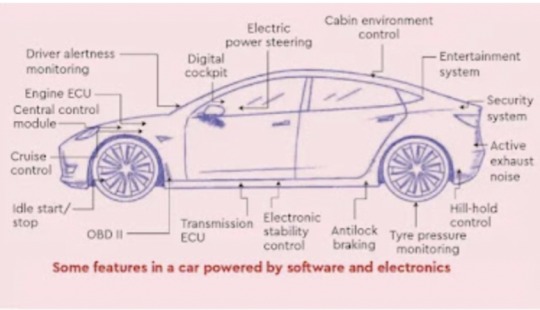#foxconn india plant
Explore tagged Tumblr posts
Text
The airline-to-software conglomerate has been in talks with the factory’s owner, Taiwan’s Wistron Corp., for months, and is looking to complete the purchase by the end of March. The two firms discussed various potential tieups but talks have now centered on Tata taking a majority of a joint venture, the people said. Tata is set to oversee the main manufacturing operation. Wistron’s 2.2 million-square-foot factory is located just over 30 miles (50 kilometers) east of Bangalore. If the acquisition goes through, Tata will take over all its eight iPhone lines, as well as the plant’s 10,000 workers, including a couple thousand engineers. Wistron would continue as a service partner for iPhones in India.
#tata group#ratan tata#tata#tata group of companies#wistron corporation#taiwan#china#iphone production in india#iphone#iphone making company#foxconn company#tata iphone plant#tata group in talks to join club of iphone makers#tata group to make iphones in india#tata iphone manufacturing#tata group close to taking over iphone maker's plant near bengaluru!#tata to manufacture iphone in india#iphone manufacturing#tata to make iphone#iphone manufacturing in india
0 notes
Text
In China, Foxconn relies on lax enforcement of the country’s labor law — which limits workdays to eight hours and caps overtime — as well as lucrative bonuses to get employees to work 11 hours a day during production peaks. Two foreign employees at the Sunguvarchatram plant told Rest of World that Foxconn used bonuses and promotional opportunities to encourage engineers and managers in India, too. But five Chinese and Taiwanese workers said they were surprised to discover that their Indian colleagues refused to work overtime. Some attributed it to a weak sense of responsibility; others to what they perceived as Indian people’s low material desire. “They are easily content,” an engineer deployed from Zhengzhou said. “They can’t handle even a bit more pressure. But if we don’t give them pressure, then we won’t be able to get everything right and move production here in a short time.” Three current and former Foxconn employees told Rest of World that the foreign managers and technicians hurled the same abusive language they used at home at underperforming Indian workers. It happened less often after some of them complained to HR, one employee said. But the foreign staff are still frustrated by local workers’ performance. “They know how to do it, but they are slow,” the employee said. “They even walk slowly.” A foreign manager complained that Indian workers requested leave too frequently — to care for sick family members, for instance — or for reasons they considered insufficient, such as a “blood moon” lunar eclipse, deemed particularly inauspicious for women. They and another foreign manager said Indian workers were also frequently late to meetings.
15 notes
·
View notes
Text
The Surge of Mobile Exports from India in 2024

In recent years, India has emerged as a formidable player in the global electronics landscape, particularly in the realm of mobile exports. As of 2024, the Indian mobile export industry is witnessing significant growth, driven by favorable government policies, foreign direct investment, and a burgeoning domestic market. This article explores the current state of mobile export from India, the key players involved, and the implications for the global smartphone market.
Overview of Mobile Exports from India
The mobile export from India has seen a meteoric rise, with projections indicating that exports could exceed $12 billion in value by the end of 2024. This impressive growth can be attributed to several factors, including the government’s "Make in India" initiative and the Production Linked Incentive (PLI) scheme, both designed to bolster domestic manufacturing and attract international investments.
Growth Drivers
Several factors are propelling the growth of mobile exports in India:
1. Government Initiatives
The Indian government has introduced various programs to promote local manufacturing, such as tax breaks, subsidies, and the establishment of electronics manufacturing clusters. These initiatives aim to attract both domestic and foreign manufacturers to set up production facilities in India, which has proven effective in enhancing the mobile export sector.
2. Investment in Infrastructure
Investment in infrastructure has also played a critical role in boosting mobile exports. Improved logistics, reliable power supply, and streamlined regulatory processes make India an attractive destination for mobile manufacturers. This investment is crucial for facilitating large-scale production and ensuring timely exports.
3. Technological Advancements
The rapid advancement of technology has enabled Indian manufacturers to produce high-quality smartphones that meet global standards. Companies are increasingly investing in research and development to innovate and improve their product offerings, further enhancing their competitiveness in the international market.
4. Skilled Workforce
India’s vast pool of skilled labor is another significant factor driving mobile exports. The country boasts a workforce proficient in electronics manufacturing and engineering, enabling companies to maintain high production standards and innovate effectively. This skilled labor force is essential for both domestic and foreign companies seeking to enhance their manufacturing capabilities in India.
Key Mobile Exporters in India
Several major players dominate the mobile export landscape in India, Leading mobile exporter in India are:
1. Apple Inc.
Apple has been a trailblazer in the Indian mobile export sector, establishing manufacturing facilities through its contract manufacturers like Foxconn and Wistron. The production of iPhones in India has not only bolstered local employment but has also significantly contributed to India’s mobile export data.
2. Samsung Electronics
Samsung operates one of the largest smartphone manufacturing plants in Noida, where it produces a wide range of devices, from budget models to flagship smartphones. The company has ramped up its export operations, making it a critical player in the Indian mobile export market.
3. Xiaomi
Xiaomi has rapidly gained a significant market share in India, thanks to its affordable smartphones. The company has invested heavily in local manufacturing, exporting a considerable volume of devices to countries across Southeast Asia and Africa.
4. Vivo and Oppo
Both Vivo and Oppo, Chinese smartphone manufacturers, have established substantial production facilities in India. They focus on catering to the growing demand for mid-range smartphones, further enhancing India’s export capabilities.
5. Lava International
As a homegrown brand, Lava International has also made strides in mobile exports. The company primarily targets budget-conscious markets, exporting feature phones and affordable smartphones to various countries.
Analyzing Mobile Export Data
The mobile export data for 2024 indicates robust growth, with significant exports to key markets including:
1. North America
India has become an essential supplier of smartphones to North America, with Apple’s production in India catering to a large portion of the U.S. market. This trend is expected to continue as more brands establish manufacturing operations in India.
2. European Union
Countries in the EU, particularly Germany and the UK, have seen increased imports of Indian-manufactured smartphones. Samsung and Xiaomi lead this charge, exporting a diverse range of devices to meet consumer demand.
3. Southeast Asia
Indian smartphone manufacturers are tapping into the growing demand in Southeast Asian countries like Indonesia, Vietnam, and Thailand. Competitive pricing and quality have made Indian smartphones increasingly popular in these regions.
4. Middle East and Africa
The demand for affordable smartphones in the Middle East and Africa has surged, making these regions vital markets for Indian manufacturers. Brands like Lava and Xiaomi are successfully exporting budget-friendly smartphones, addressing the needs of price-sensitive consumers.
Understanding Mobile Phone HS Code
The Harmonized System (HS) code plays a crucial role in facilitating international trade. The mobile phone hs code is 8517.12, which covers smartphones capable of connecting to cellular networks. Accurate classification using the HS code is essential for mobile exporters in India to ensure compliance with customs regulations and to expedite the export process.
Conclusion
The mobile export landscape in India is poised for significant growth in 2024, with the country solidifying its position as a key player in the global smartphone market. Supported by government initiatives, foreign investments, and a skilled workforce, India is well-equipped to meet the growing demand for mobile devices worldwide.
As Indian manufacturers continue to innovate and expand their production capabilities, the outlook for mobile exports remains positive. By leveraging its strengths and addressing challenges, India can capitalize on its position in the global supply chain, ensuring sustainable growth and economic benefits for years to come. The future of mobile exports from India is bright, and the country is set to make its mark on the international stage. However if you need the list of smartphone exports by country, mobile phone HS code or global trade data connect with import and export data provider platforms like Seair Exim solutions.
Post By:
Seair Exim Solutions
Phone No.: 099900 20716
Address: B1/E3 Mohan Cooperative Industrial Estate Near Mohan Estate Metro Station Opposite Metro Pillar No:-336, NH-19, New Delhi, Delhi 110044
Also Read : A Comprehensive Guide to Garment Exports from India in 2024
#global trade data#international trade#export#trade data#trade market#global market#import export data#mobile#mobile export data#mobile hs code#mobile export#mobile exporter#mobile market#mobile industry#mobile trade
2 notes
·
View notes
Text
SEMICONDUCTORS
(How India is progressing in this sector)
1.What is a Semiconductor?
Semiconductors are materials which has electrical conductivity ranging between conductors and insulators. Conductors are good conductors of electricity while Insulators are bad conductors of electricity.


2.Where is a semiconductor used?
Semiconductors are used in manufacture of various electronic devices like diodes, transistors and integrated circuits. The most popular use of a semiconductor is in cars. In vehicles these semiconductor chips are used to control emission systems, driver assist systems etc. Not only in electric cars these chips are also used in petrol cars.


3.A Semiconductor is made up of which material?
Generally a Semiconductor chip is made up of silicon, germanium and gallium arsenide. Out of these three germanium is the oldest.
4.How will a semiconductor help?
First of all semiconductors regulate the flow of electricity and assist in making electronics function. Secondly the electrical conductivity of a semiconductor can be controlled over a wide range making them versatile for various applications. As I told you earlier that a semiconductor is not only used in electric cars but also in petrol cars, this is because semiconductors increase fuel efficiency in cars. By using semiconductors in engine control systems car manufacturers can achieve more precise control of the engine resulting in improved fuel economy and lower emissions.
So these were some common questions people ask when they hear about a semiconductor.
Now you must know that how it will help India and what steps India is taking to manufacture semiconductors in India.
At present Taiwan, USA, Japan, South Korea, China, Israel, Netherlands, UK and Germany can manufacture semiconductors. Out of these countries China and Taiwan produce a large amount of semiconductor.
More exciting thing was that USA and China were in contention with each other in this matter. During era of Donald Trump there aroused a semiconductor war between USA and China. USA wanted to disrupt China's semiconductor manufacturing and hence put a lot of sanctions on China. USA also funded Taiwan and wanted Taiwan to produce more semiconductors than China.


In all this India was benefited a lot. India also wanted to develop semiconductor plants in country and facilitate ATMANIRBHAR BHARAT initiative.
https://ism.gov.in/ this is the link of Government's India Semiconductor Mission. This mission aims at forming a semiconductor ecosystem in India.


Government of India is also working on many other semiconductor initiatives like SPECS initiative. Moreover a joint venture of Vedanta electronics manufacturing giant Foxconn has finalised Dholera Special Investment Region near Ahmedabad for setting up their semiconductor display manufacturing facility.

So much progress is happening in India and surely it will facilitate India's economy and will also provide more job opportunities. India will surely emerge as a Developed nation in upcoming years and these semiconductor initiatives are like a cherry on the cake.
Watch this video for more info.
I hope you liked my article
Pls put forward your views in comment section
Till then PEACE OUT........
My insta : sm_it_22
~Written By Smit.
3 notes
·
View notes
Text
Darshan Hiranandani : Hiranandani Group Unveils Plans for India’s Second Semiconductor Park

In a landmark development for India’s semiconductor industry, the Hiranandani Group, under the leadership of CEO Darshan Hiranandani, has announced plans to establish the country’s second semiconductor park. This ambitious project will be located in the Yamuna Expressway Industrial Development Authority (YEIDA) region, near Noida, Uttar Pradesh. With this initiative, Hiranandani Group aims to position India as a key player in the global semiconductor supply chain.
The proposed park will follow in the footsteps of the semiconductor and display manufacturing facilities already being set up by Vedanta Limited and Taiwanese company Foxconn at the Dholera Special Investment Region (SIR) in Ahmedabad, Gujarat.
Hiranandani’s semiconductor arm, Tarq Semiconductors Private Limited, has officially applied for permission under the Indian Semiconductor Mission Scheme, submitting an application to both the Central Government and the Uttar Pradesh government. The company has already paid Rs 50 Lakhs in application fees. Once approved by the Centre, the UP state cabinet will allocate land for the project.
At the UP Global Investors Summit in February 2023, Hiranandani Group signed a memorandum of understanding (MoU) with the Uttar Pradesh government, committing to invest INR 170 billion in the development of the semiconductor park. As per the MoU, Tarq Semiconductors will set up advanced ATP (Assembly, Testing, and Packaging) plants for semiconductor production, covering three types of production lines: legacy, mature, and complex. The first ATP plant is set to begin in phase one over the next 24 months, with the second and third plants to follow in the second phase, over a similar timeline. The project is expected to create approximately 1,000 jobs.
In a letter to the CEO of YEIDA, Darshan Hiranandani stated that the initial phase of the project will attract an investment of over Rs 25 billion. He further emphasized that Hiranandani Group has seen great success in Uttar Pradesh through its data centre arm, Yotta Data Services Pvt. Ltd., and is now eager to expand its footprint by diving into the semiconductor sector.
This semiconductor park marks a significant milestone in India’s push to become a global leader in semiconductor manufacturing. Supported by initiatives like the Indian Semiconductor Mission, which aims to foster a robust semiconductor ecosystem within the country, the project aligns with India’s ambitions to reduce its dependence on foreign semiconductor imports.
Darshan Hiranandani - As India continues to draw global investments in the semiconductor industry, Hiranandani Group’s proposed park is set to be a key catalyst in strengthening India’s role in the global semiconductor supply chain. The park is expected to contribute not only to job creation but also to the overall economic development of the region, driving advancements in science and technology.
0 notes
Text
India seeks report on iPhone factory hiring practices

The Indian government has sought a detailed report from Tamil Nadu state following media reports that Apple supplier Foxconn was allegedly rejecting married women for iPhone assembly jobs.
A Reuters investigation alleged that Foxconn had excluded married women from jobs at its main India iPhone plant near Chennai, citing their greater family responsibilities compared to unmarried women.
The federal labour ministry says the law "clearly stipulates that no discrimination (is) to be made while recruiting men and women workers".
Neither Apple nor the Tamil Nadu state government responded to requests for comment from Reuters.
The BBC has also reached out to Foxconn and the Tamil Nadu labour department for a response.
Foxconn, the largest supplier of Apple iPhones, set up its first factory in Tamil Nadu in 2017 but has since been aggressively expanding its operations in India.
In 2023, it began assembling the iPhone 15 in the state and earlier this year, Foxconn tied up with Google to make Pixel smartphones in Tamil Nadu.
Rights activists say the reports about the firm's hiring practices in India are concerning, given that thousands look to its factories for employment opportunities.
Reuters said it spoke to numerous employees and Foxconn hiring agencies for the story.
The report said that hiring agents and Foxconn HR sources "cited family duties, pregnancy and higher absenteeism as reasons why Foxconn did not hire married women at the plant".
This isn't the first time the firm has come under the scanner for its labour practices.
In 2018, a US-based rights group had accused the firm of overworking and underpaying temporary workers at its factory in China that manufactured products for Amazon.
In 2022, its iPhone factory in China saw protests by workers who claimed that they had not been paid certain dues.
0 notes
Text
Google leases New Bengaluru Office Space Over Rs 4 Crore Monthly Rent
Google’s tremendous expansion in India is still ongoing. According to a report by the Economic Times (ET), the internet giant has acquired a sizeable 649,000 square feet of office property in Bengaluru’s Whitefield neighborhood. With this important leasing arrangement, Google demonstrates its long-term commitment to the Indian market and solidifies Bengaluru’s position as a major operational base.
Intelligent Growth in Bengaluru
The recently rented office space is located in Whitefield’s well-known business development, Alembic City. Google’s expanding Bengaluru team now has a contemporary, well-connected office thanks to this advantageous location. According to the article, the lease would have a lock-in duration of three years and a monthly rental cost of Rs 62 per square foot. This demonstrates Google’s large investment in its Bengaluru operations and corresponds to a huge monthly rent of almost Rs 4,02,38,000.
India as a Driver of Growth
This most recent event coincides with Google’s recent US worker reorganization. The corporation seems to be refocusing on India even if there have allegedly been downsizings in several key jobs in the US locations. Success Past Investments
The leasing arrangement for Bengaluru expands Google’s expanding Indian real estate holdings. A sizable 600,000 square feet of office space in Hyderabad were leased again by Google Connect Services India Pvt. Ltd. in 2022. The business has secured 1.3 million square feet of office space in Bengaluru by entering into a separate arrangement with Bagmane Developers. The amount of office space that Google owns in India has increased by an astounding 3.5 million square feet since 2020. **
Innovation Hub: India
Google’s physical growth in India is a reflection of its increasing dedication to the nation’s thriving IT sector. At the moment, Bengaluru, Hyderabad, Delhi, Gurgaon, and Mumbai are the five major Indian cities where the firm is present. This enormous real estate footprint, which includes 9.3 million
Beyond Office Space: Pixel Production in India
Google has more ambitious intentions for its growth in India than just leasing office space. The corporation is aggressively entering the nation’s hardware manufacturing market. There are plans to start producing Pixel smartphones at a Foxconn plant in Tamil Nadu. With this move, Google is demonstrating its intention to take advantage of India’s strong manufacturing sector and meet the country’s expanding need for Pixel smartphones.
Drone Manufacturing Takes Flight
Google is also looking at the possibilities of producing drones in Tamil Nadu. Although specifics are still lacking, this action implies that Google is dedicated to creating cutting-edge technology in India. India’s rising significance as a manufacturing base for Google’s hardware aspirations is highlighted by the country’s possible manufacture of Pixel smartphones and drones.
A Look Ahead: Pixel 8 Launch and Beyond
The Pixel 8 model is anticipated to be the first smartphone produced as part of the Pixel project. This action demonstrates Google’s calculated strategy to serve the price-conscious Indian market, support the country’s smartphone ecosystem, and create employment locally. Anticipation is expected for the Pixel 8 launch in India as it represents Google’s commitment to offering its newest hardware advances to the Indian market.
India’s Tech Revolution: Google at the Forefront
Google’s significant expenditures in local manufacturing, office space, and talent acquisition reinforce its role as a key player in India’s continuing digital revolution. The organization’s dedication to India goes beyond merely setting up shop there. Google makes significant investments in the nation’s tech environment, with the goal of promoting innovation. Google is positioned to have a significant impact on how India’s IT scene develops going forward because to its deliberate development plans and emphasis on domestic manufacturing.
Read more: Marketing News, Advertising News, PR and Finance News, Digital News
0 notes
Text
Foxconn's $500 Million Investment in India Strengthens Manufacturing Landscape

Introduction:
In a bold move that strengthens India's position as a key player in the global manufacturing arena, Foxconn, the prominent Apple contract partner, has announced a substantial investment of $500 million in establishing manufacturing plants in Telangana, a southern Indian state. This strategic decision marks another step forward in Foxconn's expansion plans within the flourishing South Asian market, showcasing its confidence in India's potential as a manufacturing powerhouse. With Prime Minister Narendra Modi's push for local manufacturing, Foxconn joins other major players like Wistron and Pegatron, lured by financial incentives and a vast consumer base. This blog explores the implications of Foxconn's investment, the growing interest from Apple's manufacturing partners, and India's ascending status in the global manufacturing sector.
Foxconn Expands Manufacturing Footprint:
Building on its existing presence in India, Foxconn has been producing iPhones in the country since 2006. Winning the bid to manufacture AirPods earlier this year has further solidified their commitment to the Indian market. The $500 million investment in Telangana will pave the way for establishing new manufacturing plants, leading to the creation of approximately 25,000 direct jobs in the initial phase alone. This move highlights Foxconn's recognition of India's potential as a hub for mid-to-high-end products, aligning with the preferences of its clientele.
India's Favourable Factors:
India's favorable factors, including Prime Minister Modi's initiatives to boost local manufacturing, have attracted significant investments from global players like Foxconn. The country's population of 1.4 billion presents a huge consumer market, providing significant growth opportunities for manufacturers. Foxconn's chairman, Young Liu, expressed the company's confidence in India's competitive advantages, such as skilled labor, a well-established supply chain, and efficient logistics. Recognizing the potential for increased production yields, Foxconn aims to capitalize on India's advantages while continuing to expand its assembly and component operations in the country.
Apple's Expanding Manufacturing Infrastructure:
The growing interest from Apple's manufacturing partners in India coincides with Apple's strategic plans to diversify its manufacturing infrastructure beyond China. As part of this endeavor, Apple opened its first two retail stores in India recently, signaling a stronger presence in the country. In line with this trend, JP Morgan analysts predict that Apple could increase its iPhone manufacturing capacity in India to account for 25% of total iPhones produced by 2025. This expansion is a testament to India's attractiveness as a manufacturing destination and its potential to meet global demand for Apple products.
India's Rising Prominence in Manufacturing:
The investments from major manufacturing players like Foxconn, Wistron, and Pegatron underscore India's rising prominence in the global manufacturing sector. With government incentives, a vast consumer base, and favorable labor costs, India has become an attractive destination for companies looking to establish production facilities. By strengthening its manufacturing ecosystem, India aims to reduce its dependence on imports and foster domestic production, contributing to economic growth and employment generation.
Conclusion:
Foxconn's $500 million investment in manufacturing plants in Telangana bolsters India's position as a major player in the global manufacturing landscape. With an already established manufacturing presence, Foxconn's expansion further enhances India's appeal to other companies seeking to capitalize on the country's vast consumer market and favorable manufacturing ecosystem. As Apple and its manufacturing partners set their sights on India, the country's potential as a manufacturing powerhouse continues to grow. With Prime Minister Modi's focus on local manufacturing and initiatives to attract foreign investment, India is well-positioned to become a leading hub for mid-to-high-end product manufacturing.
Also visit- Fox&Angel - Best Strategy Consulting Firm
This post was originally published on: Foxnangel
#Apple India#Business expansion#business growth#FDI in India#Foreign Direct Investment#Fox&Angel#FoxNAngel#Franchise opportunities in India#Grow with India#India market entry#strategy consulting
1 note
·
View note
Text
“The transformation of concrete labors into abstract labor renders the labor into something akin to the notorious pink goo or pink slime that industrial, processed meat now contains,” the scholar McKenzie Wark wrote. On the ground, the work of girls is being mined for profit in concrete ways: As India becomes a hub for tech manufacturing, Apple contractors like Foxconn and Tata Group are working hard to recruit more women workers as contract labor for their iPhone assembly plants. As many as 85 percent of factory workers in India working for such Apple contractors are women. While contract work is precarious and doesn’t include benefits, companies like Foxconn offer free food, housing, and transportation. The last time these subcontractors rushed to hire hoards of new workers, over 250 workers fell sick due to tainted food, triggering protests and factory shutdowns. According to Reuters, Foxconn told Indian state officials that it had “ramped up production too quickly” ahead of the iPhone 13 launch. By the time the Apple icon turns up on your screen, the device has already been shaped by the hands of women hard at work. When creating and sharing ourselves through the internet, we become enmeshed in the abstract labor of being a girl online. If we extrude ourselves through the filters and hashtags, we come out the other side as a sludge of marketable microtrends, aesthetics, subcultures, and niche celebrities — our own version of the notorious pink goo.
Michelle Santiago Cortés, The Hyperlinked Hyperfeminine
0 notes
Text
Foxconn to set up chip testing plant in India
#foxconn#taiwan#hcl technologies#business#business news#business in india#asiantimes#world news#breaking news#india#global news
1 note
·
View note
Photo

Watch Foxconn Provides $1 Billion to Funding in Big Apple India Plant - Newest Apple Updates
0 notes
Link
Foxconn Seeks to Work With STMicro to Build India Chip Plant – The Lifestyle Insider
0 notes
Text
Foxconn Starts Production of Upcoming Apple iPhone 15 in Tamil Nadu Ahead of September Launch
In a significant stride towards bolstering the “Make in India” initiative, Apple Inc. is poised to kickstart the production of its eagerly anticipated iPhone 15 in the southern state of Tamil Nadu. A recent report has unveiled that the Foxconn Technology Group’s manufacturing plant in Sriperumbudur is gearing up to roll out the latest iPhone iterations merely weeks after they commence production in Chinese factories. This strategic move aims to bridge the gap between Indian and Chinese manufacturing operations.
0 notes
Text
#Breaking: #Foxconn unit to sign $194 mln components plant deal with #India's #Tamil #Nadu-source
Foxconn unit to sign $194 mln components plant deal with India's Tamil Nadu-source https://t.co/auMfH6iGhI pic.twitter.com/trcjOUGHqs — Reuters (@Reuters) July 31, 2023 Source: Twitter

View On WordPress
0 notes
Text
iPhone Assembler Foxconn in Talks With TSMC and TMH to Setup Semiconductor Fabrication Units in India: Report
Foxconn is in talks with Taiwan Semiconductor Manufacturing Company (TSMC) and Japan’s TMH Group for technology and joint venture partnerships to start semiconductor fabrication units in India, the Economic Times reported on Friday.Meanwhile, the Gujarat government is holding talks with Foxconn over a semiconductor plant, a top government official told Reuters, days after the Taiwanese […] The post iPhone Assembler Foxconn in Talks With TSMC and TMH to Setup Semiconductor Fabrication Units in India: Report appeared first on TECH - WEB DEVELOPMENT NEWS. https://tech-webdevelopment.news-6.com/iphone-assembler-foxconn-in-talks-with-tsmc-and-tmh-to-setup-semiconductor-fabrication-units-in-india-report/
0 notes
Text
youtube
Indians Spent $10 Million on Schengen Visas They Never Got + more news! -12/7/2023
Last year, Indians spent $10 million on Schengen visas they never got. 18% of the Schengen visa applications by Indians were rejected. India got the second-highest Schengen visa rejections in the world. Why do Indians get so many rejections? Is the Indian passport weak?
In a surprising turn of events, Foxconn, known for assembling Apple products, has withdrawn from a $19.5 billion joint venture with Vedanta to establish semiconductor and display production plants in Gujarat, India. While no specific reasons were given for the withdrawal, Vedanta and Foxconn have reaffirmed their commitment to India’s semiconductor mission.What impact will this have on India’s ambitious in the semiconductor space?
China has cited "health reasons" for its foreign minister’s weeks-long absence from the public eye. Qin Gang was last seen on June 25, leading to speculation about his health. Though Beijing initially claimed to be "not aware" of such reports, it has now confirmed them.
Turkish President Erdogan agreed to support Sweden's NATO bid in last-minute talks ahead of the alliance's summit in Lithuania. Erdogan had been opposing Sweden's entry since last year, citing the country's support for Kurdish dissidents. What made him change his position? What's in it for Erdogan?
In a first, a transgender woman has won the title of Miss Netherlands, which invited mixed reactions. A wave of harsh criticism slammed the decision to crown the trans woman. Others called her win a landmark moment for trans rights. Should trans women be allowed to compete with naturally-born women?
An urgent meeting is taking place in Jamaica to determine the future of deep sea mining. The ocean floor has an abundance of rare metals, but it is also a fragile ecosystem. Some countries want to begin mining the ocean floors despite potential risks to the environment.
A UN body has been tasked to come up with deep sea mining regulations after the country of Nauru put in a formal request to mine the oceans. But critics of the plan are asking for a moratorium on deep sea mining. Palki Sharma explains why.
0 notes